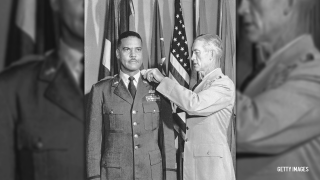
The San Diego Air & Space Museum will Friday open its new permanent exhibit "Breaking Barriers," honoring pioneering Black American aviators and astronauts throughout history.
"The San Diego Air & Space Museum is proud of its long history of honoring and recognizing the contributions of pioneering Black American aviators and astronauts, both through the exhibits in our museum and through the prestigious International Air & Space Hall of Fame," said Jim Kidrick, president and CEO of the museum.
"The new `Breaking Barriers' exhibit is a natural permanent extension of our longstanding salute to the Tuskegee Airmen through our P-51 Mustang, which is painted with their famous distinctive Red Tail Squadron design, as well as through the Black American innovating aviators we honor in the Hall of Fame on display at our museum every day."
According to the museum, the centerpiece of the exhibit is an animatronic featuring the likeness of Benjamin Oliver Davis, Jr. exploring the history of pioneering Black American aviators and astronauts.
Get San Diego local news, weather forecasts, sports and lifestyle stories to your inbox. Sign up for NBC San Diego newsletters.
Davis became the first Black American brigadier general in the United States Air Force during World War II and was "instrumental in integrating the Air Force," a museum statement read. While working at the Pentagon, Davis created the Air Force Demonstration Squadron, known as the Thunderbirds in 1953. Davis was inducted into the prestigious International Air & Space Hall of Fame at the San Diego Air & Space Museum in 1996.
In addition to Brigadier General Davis, the men and women featured in the "Breaking Barriers" exhibit include:
- Vernice Armour: The first Black American woman naval aviator and first female combat aviator in the United States Marine Corps;
- James Herman Banning and his mechanic, Thomas Cox Allen: The first Black Americans to fly across the United States on Oct. 9, 1932;
- Guion Stewart Bluford Jr.: The first Black American to travel to space on Aug. 30, 1983;
- Janet Harmon Bragg: The first Black American woman to earn a commercial pilot's license in 1942;
- Willa Beatrice Brown: The first Black American woman to earn a pilot's license within the United States and the first Black American officer in the Civil Air Patrol;
- Eugene Jacques "James" Bullard: Flew for France during World War I as the first Black American military pilot;
- Elizabeth "Bessie" Coleman: The first Black American woman and first Indigenous American to receive a pilot's license on June 15, 1921;
- Mae Carol Jemison: The first Black American woman to travel into space on Sept. 12, 1992;
- Lloyd W. "Fig" Newton: The first Black American pilot in the United States Air Force Demonstration Squadron known as the Thunderbirds; and
- William Jenifer Powell: A pioneering advocate of Black aviation in the United States.
The exhibit and animatronic of Davis are located in the museum's World War II Gallery, which proudly displays a P-51 Mustang painted in the Tuskegee Airmen's distinctive "Red Tail" Squadrondesign to honor the United States Air Force's first all-Black American squadron.

